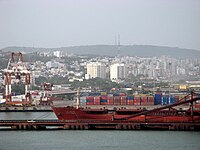
Photo from wikipedia
In the Kiel Fjord, western Baltic Sea, an experimental culture of Fucus vesiculosus and Fucus serratus has been established in order to develop a sustainable method for biomass production of… Click to show full abstract
In the Kiel Fjord, western Baltic Sea, an experimental culture of Fucus vesiculosus and Fucus serratus has been established in order to develop a sustainable method for biomass production of these species. The cultivation method includes the unattached rearing of fronds in drifting baskets and their vegetative reproduction by cutting of small vegetative apices. In this study, we performed culture experiments to measure growth rates with this method at different initial stocking densities (1–5 kg m−2) and during different seasons of the year. Using the results, we modelled growth over 1 year for different cultivation scenarios (different initial stocking densities (1–4.75 kg m−2) and harvest densities (1.25–5 kg m−2)) in order to identify optimal scenarios and estimate annual yields and the number of necessary harvests in these scenarios. Fucus vesiculosus showed a parabolic yield–density relationship with decreasing yields at high initial stocking densities (> 2.5 kg m−2). In contrast, F. serratus showed an asymptotic yield–density relationship with rather constant yields at high initial stocking densities. Both species showed a typical seasonal growth pattern with low growth rates during winter and high growth rates during summer; however, F. serratus seemed to be growth limited during summer which was not observed for F. vesiculosus. The modelling results reflected the results of the Density experiment: for F. vesiculosus, optimal cultivation scenarios were found for intermediate cultivation densities (initial stocking densities, 1.75–2.25 kg m−2; harvest densities, 3–4 kg m−2); for F. serratus, optimal cultivation scenarios included higher densities (initial stocking densities, 2.5–4 kg m−2; harvest density, 5 kg m−2). The model scenarios predicted maximal annual yields of 6.65–6.76 kg m−2 for F. vesiculosus and 6.88–6.99 kg m−2 for F. serratus. For both species, the number of harvests necessary to achieve these yields varied depending on the cultivation scenario from 2 to 6. Scenarios with only 1 harvest per year yielded slightly lower annual yields. We conclude that the modelling results offer a valid and helpful orientation for future efforts to produce Fucus species in commercial culture.
Journal Title: Journal of Applied Phycology
Year Published: 2021
Link to full text (if available)
Share on Social Media: Sign Up to like & get
recommendations!